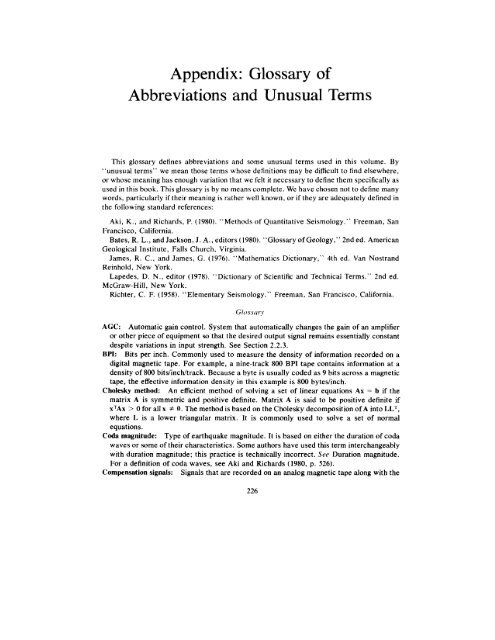principles and applications of microearthquake networks
principles and applications of microearthquake networks
principles and applications of microearthquake networks
Create successful ePaper yourself
Turn your PDF publications into a flip-book with our unique Google optimized e-Paper software.
Appendix: Glossary <strong>of</strong><br />
Abbreviations <strong>and</strong> Unusual Terms<br />
This glossary defines abbreviations <strong>and</strong> some unusual terms used in this volume. By<br />
“unusual terms” we mean those terms whose definitions may be difficult to find elsewhere,<br />
or whose meaning has enough variation that we felt it necessary to define them specifically as<br />
used in this book. This glossary is by no means complete. We have chosen not to define many<br />
words, particularly if their meaning is rather well known, or if they are adequately defined in<br />
the following st<strong>and</strong>ard references:<br />
Aki, K., <strong>and</strong> Richards, P. (1980). “Methods <strong>of</strong> Quantitative Seismology.“ Freeman, San<br />
Francisco, California.<br />
Bates, R. L., <strong>and</strong> Jackson, J. A., editors (1980). “Glossary <strong>of</strong> Geology,” 2nd ed. American<br />
Geological Institute, Falls Church, Virginia.<br />
James, R. C., <strong>and</strong> James, G. (1976). “Mathematics Dictionary,” 4th ed. Van Nostr<strong>and</strong><br />
Reinhold, New York.<br />
Lapedes, D. N., editor (1978). “Dictionary <strong>of</strong> Scientific <strong>and</strong> Technical Terms.” 2nd ed.<br />
McGraw-Hill, New York.<br />
Richter, C. F. (1958). “Elementary Seismology.” Freeman, San Francisco, California.<br />
Glosscir?<br />
AGC: Automatic gain control. System that automatically changes the gain <strong>of</strong> an amplifier<br />
or other piece <strong>of</strong> equipment so that the desired output signal remains essentially constant<br />
despite variations in input strength. See Section 2.2.3.<br />
BPI: Bits per inch. Commonly used to measure the density <strong>of</strong> information recorded on a<br />
digital magnetic tape. For example, a nine-track 800 BPI tape contains information at a<br />
density <strong>of</strong> 800 bitsiinchltrack. Because a byte is usually coded as 9 bits across a magnetic<br />
tape, the effective information density in this example is 800 bytedinch.<br />
Cholesky method: An efficient method <strong>of</strong> solving a set <strong>of</strong> linear equations Ax = b if the<br />
matrix A is symmetric <strong>and</strong> positive definite. Matrix A is said to be positive definite if<br />
xTAx > 0 for all x # 0. The method is based on the Cholesky decomposition <strong>of</strong>A into LLT,<br />
where L is a lower triangular matrix. It is commonly used to solve a set <strong>of</strong> normal<br />
equations.<br />
Coda magnitude: Type <strong>of</strong> earthquake magnitude. It is based on either the duration <strong>of</strong> coda<br />
waves or some <strong>of</strong> their characteristics. Some authors have used this term interchangeably<br />
with duration magnitude; this practice is technically incorrect. See Duration magnitude.<br />
For a definition <strong>of</strong> coda waves, see Aki <strong>and</strong> Richards (1980, p. 526).<br />
Compensation signals: Signals that are recorded on an analog magnetic tape along with the<br />
226






